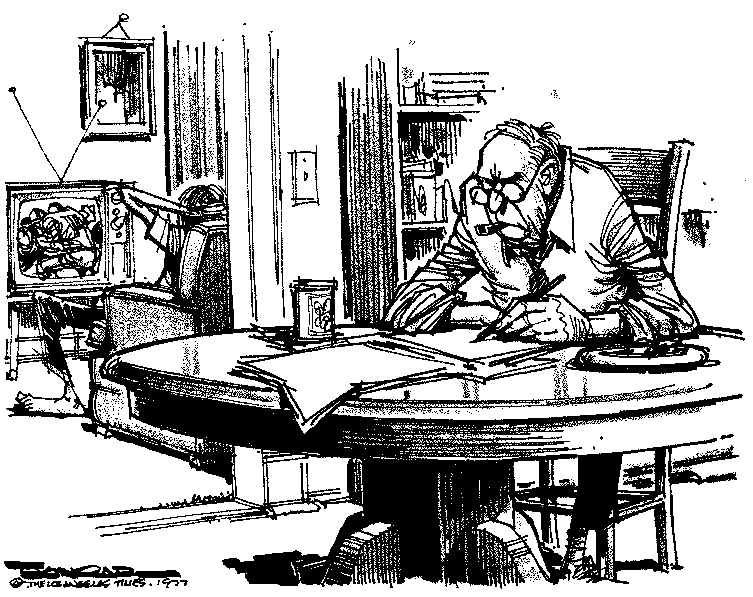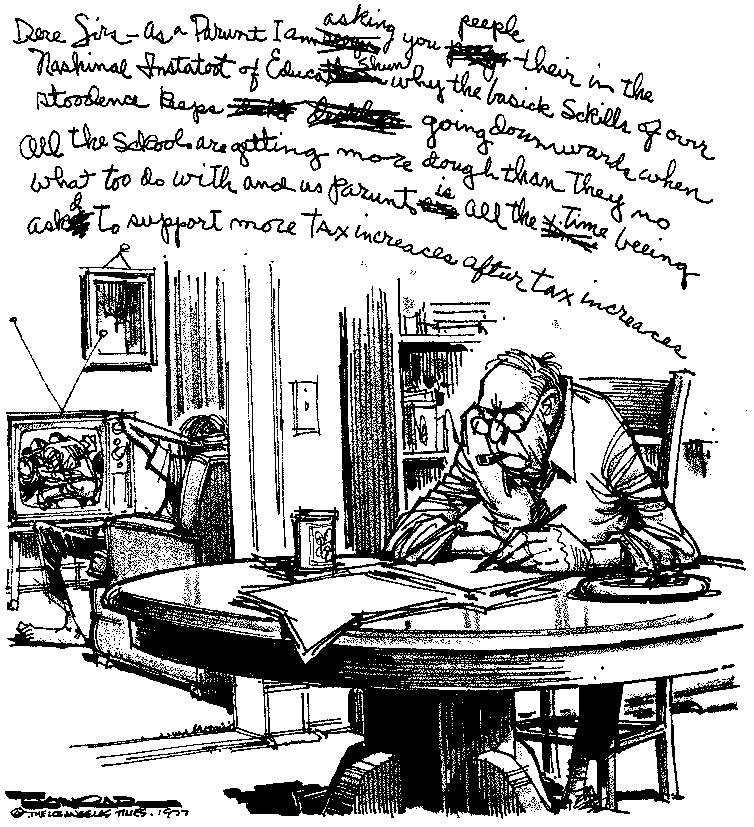Italicized links open a new window to an external site
Cartoonist for a Day

(click on the drawing for a larger view)
Pulitzer Prize winning editorial cartoonist Paul Conrad drew the image above. The Los Angeles Times published it on October 30, 1977. Conrad republished it as page 147 of his book Pro and Conrad (Neff-Kane Publishers, 1979). In case you wish to use it to work through this activity yourself, I have removed one critical piece of the published work - the caption (don't peek until you've tried going through as many steps below as you can on your own).
Most editorial cartoons consist of two parts - drawing and caption. The two work in tandem to create the artist's message. The object of this activity is to have your students study an editorial cartoon without its caption, identify a message the artist might have intended, then draft an appropriate caption to reinforce that message. If your students are facile artists, the opposite might also work. Give them the caption and have them come up with an appropriate drawing for it.
Conducting the activity
Select an editorial cartoon with which to work.
Hiding the caption, make a copy of it for each student in your class. You'll also need copies of the complete cartoon for distribution at the end of the activity.
Distribute the copies (caption hidden) you made.
Explain that the cartoon is missing the caption created by the artist, and that it will be the classes' job to determine an appropriate one for it.
To do so, they will follow this procedure
Individually, students will work for 5 minutes to review the cartoon and decide on a caption which they will write out.
After this initial individual work period, you'll divide the class into groups of 5 students. Each group will move to an area of the room where it can work independently.
You'll allow a 10 minute period for the groups to discuss the cartoon and reach a consensus (within each group) on a caption. Groups should not necessarily limit themselves to the captions individuals worked out on their own. Better ideas might emerge from their discussion.
The class will reconvene and a member from each group will report its result.
The class will attempt to reach a consensus selection. Again, the class need not be limited to the reported results. A new caption should be considered if a better idea emerges from the discussion.
After reaching a class consensus, distribute and discuss the artist's complete cartoon. Here is a list of questions you might want to consider.
How does the class caption compare to the one the artist created?
What clues (if any) did the artist leave in the drawing that the class missed?
What clues to the artist's intent did the class pick up from the drawing?
Where to find editorial cartoons
Daily newspaper (print or digital) editorial pages
Library and bookstore sections devoted to editorial cartoon books
Web sites
After the attacks on New York City and Washington on September 11, 2001, Cagle put up a collection of cartoons illustrating the response of the nation's cartoonists. More recently, he's begun a collection of Anthrax cartoons. For his ongoing collection on the War on Terror, click here.
Drawing Opinions (a companion web site to the PBS Documentary)
Additional Activities
The Association of American Editorial Cartoonists maintains a web site - Cartoons for the Classroom as a repository of ideas for classroom teachers. Check it out!
Other classroomtools.com activities that will help your students develop their visual literacy skills are:

(click on the drawing for
a larger view)
You can see pieces of Conrad's work online
return to the Main Events page
return to the Lesson Ideas page
copyright © 2001-2009
classroomtools.com. All Rights Reserved.
original web posting: Tuesday, March 27, 2001
last modified:
Thursday, June 18, 2009